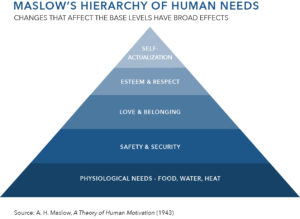Known Unknowns
The famous refrain about knowns, known unknowns, and unknown unknowns is a useful framework to think broadly about other potential catalysts that can rapidly emerge and drive meaningful change. We have identified certain factors that we believe are going to change the shape of global markets. We watch these elements closely to anticipate how change will manifest for different industries and public sectors so that organizations can prepare themselves accordingly.
Our model for evaluating catalysts also leads us to conclude that we have not identified all potential catalysts. New, unforeseen forces will emerge, and some of the influences that we view as being merely interesting as opposed to system altering will in fact turn out to be catalysts. In effect, we know there are unknowns that are likely to manifest themselves quickly, in unexpected ways that deeply matter to companies and public entities. For the known unknowns that we do not expect to identify ahead of time, our goal is to develop a framework to identify them as quickly as possible once they do start to matter.
Model-Based Assessment
Our model covers several disciplines from which we have seen catalysts emerge in the past century, namely economics, sociology, technology, and geopolitics. When we look for catalysts we are trying to anticipate the themes that have the potential to change underlying market structures, thus creating effects at a large scale.
This involves a focus on the base elements that drive people to do things, which in some cases is less intuitive than it seems. There are a number of frameworks in psychology and economics to draw from, including Maslow’s Hierarchy. Abraham Maslow established a ‘hierarchy of needs’ in a 1943 paper titled “A Theory of Human Motivation,” which depicts a pyramid of human needs, each of which must be realized in turn.
The base layer of the pyramid is comprised of physiological needs, including air, water, food, energy, and shelter. The next layer is the need for safety and security, including physical safety, financial security, and well-being. Third are needs for love, belonging, and social inclusion. The fourth layer is the need for esteem, and the fifth and final is the need for self-actualization.
At the base layers, all people have the same needs – food, energy, water, and safety. As we go up the triangle, the manifestation of people’s needs diverges. One person’s need for esteem may be found in the purchase of a mansion and a boat, another’s may be found in a life of charity. Thus, the most broad-based change agents are found in the bottom elements of the triangle, which is how we evaluate the scope of impact globally.
Changing conditions higher up the pyramid are important for governments and businesses that support people whose base needs are met. However, these effects tend to be more localized and must be studied on that basis.
After we have used this framework to evaluate the potential scope of impact, our model focuses on four elements: maturity, likelihood of occurrence, timeline, and impact. Maturity deals with both the availability of data to facilitate an accurate assessment, and the degree of market impact. Likelihood of occurrence is self-explanatory, as we are focused on themes that are extremely high probability, past the tipping point. Timelines are important, as we are primarily focused on the 5-year horizon to align with business and public sector planning cycles. Assessing impact is the last element of our model, as we are focused only on influences that are significant enough to change market behavior and necessitate action.
Types of Catalysts
Technology is critically important, but not all catalysts are technology-driven. Other fields we are tracking and analyzing on an ongoing basis include:
International politics and war: Widespread war is a catalyst with the potential to disrupt everything. The world wars of the 20th century were the most disruptive events of the century. Alliance and trade structures are important, but transregional conflict has obvious system-wide effects.
Local politics and government structures: Political structures that severely constrain or modify behavior are also potential disruptors. Socialism and communism are the clearest examples of governments that have changed underlying market conditions, but it is not inconceivable that other structures may evolve with similar effects.
Religion and broad social movements: Broad-based religious or non-religious movements impact social structures on a number of levels, with consequence for businesses and public institutions. In fact, we could argue that religion is already a catalyst, as increasing secularization in regions such as Europe and Russia has proven to be a leading indicator for the demographic crises that both regions face.
Health, famine, and disease: Positive or negative changes to aggregate health and lifestyle assumptions have the potential to change market structures. This could range from increased longevity on the positive side, to pandemic on the negative.
Technology: We cover technology-based catalysts in more detail in our technology section, but to summarize, a number of different technological developments have the potential for system-wide effects. Among them are biotechnology, genomics, artificial intelligence, space travel, energy, robotics, weapons of mass destruction, quantum computing, and nanomaterials.
Environment: Significant environmental change could disrupt market structures. Climate change is commonly pointed to as a potential catalyst, but this category also includes resource depletion and extraterrestrial activity such as solar flares or comet strikes. Regardless of the politicization of climate change, people believe this could be a major issue. For example, I recently spoke with a Bangladeshi official who stated that 20% of their landmass will be underwater by 2050 as a result of global warming, which certainly constitutes significant disruption.
Ongoing Observation
As this is an uncertain and rapidly evolving world, it is a near-certainty that some emerging catalysts will slip by if we are at this long enough. However, our model is helpful in the face of uncertainty because it gives us a screening mechanism to quickly evaluate catalysts, including those we are not actively tracking.
Businesses and public leaders can adopt a similar framework to prepare organizations for change. It begins with being aware, looking at the data surrounding new developments, and operating under the assumption that change has become the norm. Leaders must have the courage to move early to manage or take advantage of change, especially if they run organizations that are structurally slow to change.
Join the Catalyst Monitor
Join our community, where we push out regular insights to help maintain situational awareness on technological and socioeconomic trends.




